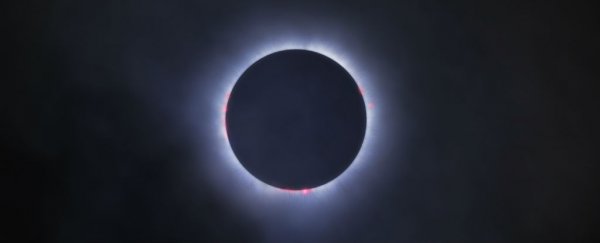It might be comforting to know that while Earth appears to be in turmoil right now - what with mass extinctions being predicted for our future, and the very real potential of having more plastic in our oceans than fish within the next few decades - our home planet is, always has been, and always will be, extraordinarily consistent.
When we're looking at Earth, not from the surface, but in the context of its position in the Solar System, the Milky Way galaxy, and the Universe, our home is entirely predictable, and NASA has been using this to forecast solar and lunar eclipses thousands of years into the future.
For example, as Brian Resnick reports over at Vox, NASA knows that on 27 January 2837, southern Mexico will experience a total solar eclipse.
Hopefully the weather will be clear that day (NASA sure isn't going to make those kinds of predictions, even if certain websites are claiming to), so whoever - or whatever - is living in Mexico in 821 years' time can get a good view.
How does NASA know the exact day, hundreds of years in the future, and place on Earth that will experience an eclipse? As Resnick explains, the US space agency keeps a 5 millennium catalog of all the eclipses, both solar and lunar, that have occurred or will occur since 1999 BC to the year 3000.
"During the 5,000-year period from -1999 to +3000 (2000 BCE to 3000 CE), Earth will experience 11,898 eclipses of the Sun," says NASA. "The statistical distribution of eclipse types for this interval is as follows: 4,200 partial eclipses, 3,956 annular eclipses, 3,173 total eclipses and 569 hybrid eclipses."
The best thing about this 5,000-year calendar is that doesn't just tell NASA that southern Mexico will get a total solar eclipse on 27 January 2837 - it can tell them what time it's going to start, peak, and finish, down to a fraction of a second.
How can NASA be so sure?
Generally speaking, the fact that Earth orbits the Sun, the Moon orbits Earth, and Earth orbits on its own axis isn't going to change any time soon - even if the Moon can be a bit inconsistent at times. This means there aren't a whole lot of variables that scientists have to deal with when making predictions into the future.
With this in mind, NASA researchers have based their calendar on something known as the Saros cycle, which predicts that any given eclipse will repeat on an '8 years, 11 days, 8 hours' cycle.
While this timeframe is constant, the place over which the eclipse will occur on Earth will continue to change, and that's why NASA's calendar is such a valuable resource for scientists and skywatchers alike.
"Because the Saros period is not equal to a whole number of days, its biggest drawback is that subsequent eclipses are visible from different parts of the globe," says NASA.
So head over to their 5,000-year calendar website and have a play around.
Resnick found the year that a total eclipse would fall on his birthday - 2212, which is too bad if he actually wants to be around to see it - and you can get a jump on your rival eclipse hunters by getting the exact dates, times, and locations of all the upcoming total solar and lunar eclipses.
It's probably the nerdiest thing you could ever do, but who are we kidding? We're all nerds around here.
